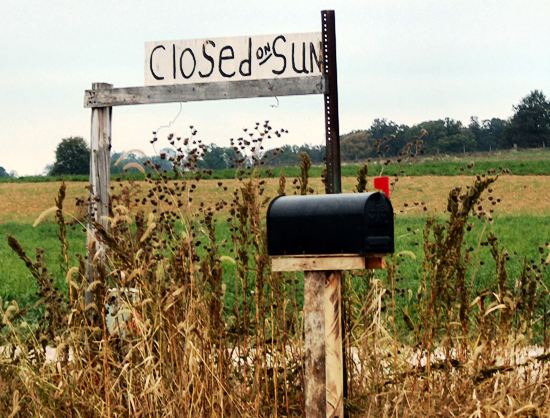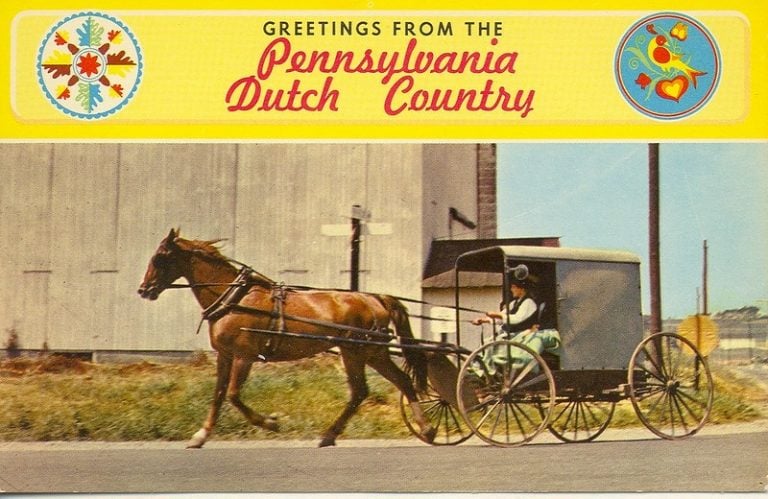Look Back In Time: A 1950s Film on the Amish (10 Observations)
What was Amish life like 65 years ago? Last week I came across a documentary called, simply, “The Old Order Amish”. This was filmed in Lancaster County and was just recently uploaded to YouTube. It’s on the Periscope Films channel, a company that preserves rare and obscure old films.

It’s a fascinating nugget from the past and I recommend watching (it’s viewable at the end of this post). The film is 32 minutes long. You will see how the Amish in Lancaster County lived in the 1950s. I had a few observations to share.
Old Order Amish Documentary
Here are some observations I had from the film, ten in total.

1. The Lancaster Amish Population is Five Times Larger Today
The Lancaster County Amish population at the time of recording was about 8,000 Amish. It’s now over five times larger (around 43,000). Though the community has grown, many if not most of the homes and farms you see in this film should still be around today.

Some look quite familiar. I imagine if I were watching this with an Amish person from the area, he’d be able to tell me who lives on these farms today.
2. Amish don’t appear too camera-shy
The Amish here don’t seem too camera-shy. We see various scenes from Amish life, including a woman demonstrating baking in a outdoor oven and listening in on some conversations. The narrator notes that “the women are extremely proud of their show china.”

3. The “Gay” Outside World
The narrator talks about “the distinction between the plain Amish world” versus “the gay outside world”. “Gay” in this case being a synonym used for “fancy” – a term once commonly used to describe Pennsylvania Dutch people who were not part of the plain Anabaptist churches.
4. Amish Farm and House?
I think this may have been filmed in part at the Amish Farm & House, the area’s oldest tourist attraction, which opened in 1955. I may be wrong, but just a hunch.
5. No SMV Triangles
One thing you’ll notice is the buggies do not contain the SMV triangles, nor the levels of lighting and reflectors you’d see on Lancaster buggies today.

The SMV triangle was not developed until the 1960s, following a study of tractor accidents by researchers at Ohio State University. After some reluctance, Amish began adopting it for their buggies and it has since been adopted around the world.
6. A visit to Amish church
We get an explanation of the Amish church service and also hear snippets – including a preacher and singing from the Ausbund.

They film when it looks like church is just getting out (note the small children frantically waving at the camera). The scenes don’t look all that different from what you would see today. Of course there would be some smaller less noticeable differences. But hairstyles and clothing appear to have changed little over six-plus decades.
Then there is food and visiting. “Late in the day the get-together breaks up,” the narrator explains, “as the older folks leave to take care of the animals, and the younger folks to take care of their courtship.”
7. Non-Amish school teacher
We get a good look inside an Amish school. The narrator notes that the Amish are adamant about their children being educated in the one-room schoolhouse. But in this case the teacher is an outsider, one with “an understanding and respect for the Amish way of life.” I believe that was more common than it would be nowadays.

Some of these children are Amish grandmas and grandpas in the community today. I wonder if any of them have had a chance to view this film. I bet they’d get a kick out of it.
8. A visit to a public sale
Next the documentary stops in at an auction. Like today, it’s a chance to buy something but also to socialize, to get some hot dogs and hot chicken corn soup. “Those who do the buying are the men,” the narrator observes. “But the women do their utmost to exert a bit of influence.”

We also get a look at corner ball or mosch ball as it’s described here.
9. Threat of “the world” was a worry even in the 1950s
The narrator discusses Amish trips to town and the threat to their “symbolic wall” protecting them from worldly influence. “And yet it could not be otherwise in the 20th century” the narrator notes, citing economic pressures and the need to make money to buy farms.
This is not a new theme and is one that is many degrees more acute today. This section hints at external pressures and business changes to come even in the late 1950s.

We also get a view of a farmer’s market, probably in Lancaster city, foreshadowing the popularity of such businesses among Lancaster County Amish today. There is also mention of “the constant threat of the speeding auto”, another ever-present concern for the Amish now.
10. Closing on an ominous note
There is a good bit more covered in the film than what I’ve discussed here. But to take a look at the film’s close, interestingly it finishes on an ominous note. The narrator asks “can the struggle between the horse and the buggy, and motorized transport, end other than disastrously for the Amish?”
“As the American personality moves towards homogenization,” we hear, “Amish non-conformity is increasingly resented.” We see scenes from a funeral procession. The narrator then suggests that “the only salvation for the Amish farmer is to remain blissfully unmindful of the attitudes of the world. His back must stay turned on the world.”

Looking back over six decades later, how accurate were these ideas? I would say that while individuals and communities may have departed from the “Amish way”, Amish society as a whole has adapted to change, in a wide variety of ways.
Some have more or less kept, or even doubled-down on, their isolation. But many others have opened up to varying degrees – through business interaction, farming co-ops, lunchpail work, greater civic involvement – while retaining their Amishness. There remains resentment for Amish as “different” – just look at discussions over things like buggy lighting or social security – but I’d argue that the overall view of the Amish is much rosier today than the tone of this film’s conclusion suggests it’s heading.
However, the point about dangers on the road is still very relevant, probably even more so, I’d think, than in the 1950s. Especially when we consider the size of the Amish population, and the increase in both cars and distractions.
Watch “The Old Order Amish”
Here’s the full film. Interested to hear about any additional things you noticed.








Portraiture
Right off the bat, those paintings in the initial moments make me wonder, do Amish get their portrait painted? Have they ever? Are those paintings maybe people from some other sect altogether? Lots of ‘cultural’ works back then staged situations. I sure thought images were against Amish beliefs.
I would guess those are just an artist’s representation, and not actual Amish who posed for portraits. That’s not something that they would normally do. Historically that sort of thing is a sign of an assimilating group.
The Old Film
Enjoyed watching the film and did not recognize how different they were from us the Englishers. I used to attend First Deaf Mennonite Church near Bird in Hand from 1970 to 1975 when I was a student at Gallaudet University (was college back then). Thanks for showing this film.
Raymond
Glad you liked it. I appreciate not only what I learn from these looks into the past, but the atmosphere of films like these. We see Amish life but there is still a distance, the formal narrator, etc.
By the way, an Amish friend and I were not too long ago driving past that church and wondering about the history. It opened my eyes to the idea of churches accommodating people with hearing impairments. Was glad to learn a bit about it.
Plain
Many people think the Amish are interesting because they are different from us. I find them to be more like us than unlike us. The shared human connection is there. This film shows how different each sect can be in historical terms. They think they are closer to god for not owning or using modern items, but when they get deathly ill, off to the men of science they go! They seem to pick and chose when to be modern or “gay”. Overall to me, they aren’t at all fascinating, just rather old fashioned.
Old-fashioned in a good way
Previously, I thought the Amish were just old-fashioned and very strict, like their portrayals by Hollywood or fictional books. However, after I read the Amish America site, my mind opened and I developed a respect for the Amish’s purposeful, careful interaction with cultural changes and their overall loving attitudes. Then, I had the privilege of meeting a number of Amish, going to their homes, and writing letters. I found delightful friends who are extremely well-versed in culture and world events, they just choose their interaction and response to the culture through the lens of their religious beliefs. I am still fairly young, but I can see that our culture badly needs a return to the old-fashioned values I experience with the Amish—friendliness, helpfulness, community-mindedness, perseverance, hard work, family values, positivity. The Amish are human, like the rest of us, but most have the courage to live differently in a culture that increasingly seems bent on self-destruction.
aversion to photography?
How do we account for the willingness of so many Amish to be photographed, even when personally recognizable? Was the Ordnung less strict then?
What a Treasure
Such a gem, like all videos from the past. Enjoyed, thank you for featuring it.
Our family enjoys TV shows on youtube from the same time period, ie Leave It to Beaver, Andy Griffith Show, Ed Sullivan, Jackie Gleason, What’s My Line, etc. Interesting to watch the Amish video in context of the same time period.
Old Order Amish film 1950s
While watching the part about kids in the one room school,
I noticed not one of the girls wearing the white prayer kapp.
Interesting. . . I thought the adults had their girls wearing the
kapp at a young age, maybe 2-3 years old. Goes to show you
what I know. Lol.
The documentary
This is an outstanding video, especially compared to almost any documentary made today. I have a file for Amish America where I put the emails I especially enjoyed and this is one of them. I have mentioned in previous responses on a variety of topics that I do not at all begrudge the Amish their freedom to practice their way of life and religion. I would not care to live as they do, but am glad that they see fit to continue a lifestyle that suits them. I admire anyone who can pretty much live “off the grid” and who know how to live off the land. I also think that their generally being “old fashioned” is admirable as well. I would like to tell them that as one who has a television and radio, they are not missing anything by not having either. It would be interesting to find out if the gristmill mentioned in the video is still in business; it is a beautiful, old stone building not unlike many in rural southeastern Pennsylvania.
In 1900 there were just 5000 total Amish world wide. By this video’s filming, there were 8000 in just Lancaster Co, PA. Now there are hundreds of thousands and still growing fast. A million Amish by 2050?
overall view of the Amish
Agreed that the overall view of the Amish is “rosier” — perhaps in step with society’s increasing dependence on technology and isolation because of social media, Amish lifestyle is romanticized a bit, as a simpler way of life that modern people crave but cannot reasonably attain!
From "no SMV triangles" to (some) Amish adopting them...
Good to see you point out the now-glaring difference of NO triangles being featured in the film, as this was not quite 10 years too early for them to have been researched, manufactured and popularized. Who.Would.Have.Thunk… that years later, after Ohio State U ceded control of this development to the ol’ Ag Engineers that development would reach a virtual, would-be dead end as far as developing this idea even further? There.Are.Problems. with allowing nominally-professional societies to have control over Certain Things that the US DOT, in all their trusting decades ago, would codify nonsense into statutes and Never Suspect that plain ol’ human greed and incestuous, industry protectionist wagon-circling years later could result in suppression of necessary safety that could fatally harm and maim the Amish, farmers and others.
safetypsychographics.com/an-end-to-smv-emblem-self-certification-and-transportation-industry-safety-product-quotes/
Unity
Amassing how they all worked together to move the building.
I wrote down my observations while watching the video on Sunday, but haven’t got around to posting them. Some of these are just more general observations, others have my bias as a member of one of the plain churches (German Baptist New Conference). I’ve studied the different plain churches since 2005, and have been very grateful for this website over the years.
Some of what I’ve noticed is in comparison to what is shown in documentaries like “The Amish.”
I’ll try to categorize the observations by topic.
1) Technology
-Generally older style (like period correct) of farm equipment compaired to the modified/improved old style farm equipment Amish seem to use today. The modifications would increase effeciency and ease of use, I think.)
-The Pre-Industrial Revolution old school “Dutch oven” the woman uses to bake in.
-Harvesting of corn-it isn’t shown, but it appears it was probably done by hand.
-During the barn raising, there is an adz being used on the mortising by both the Amish and the English. The tools used wouldn’t have been too different, if at all, than what was common among mainstream society at the time.
2) Plain Clothing styles are different than today.
-More black hats that the typical Lancaster straw hats seen today.
-Clothing may have been less of a set identity symbol.
-Cowboy at around the 6 minute mark with cut-off sleeves on a t-shirt/undershirt.
-Straw and black felt hats had wider brims which were turned up “cowboy style” as opposed to flat. The crowns of the hats also seem shorter.
-Wider suspenders (and fewer colors and patterns on them).
-Those barn door pants are very high waisted.
-The young men wore bow ties at the singing.
-No short sleeved shirts but long sleeves are rolled up over the elbow (one Amishman seems to have short sleeves at 27:07).
-Vests in town seem more common.
-Girls not wearing the kapp and skirt hemlines on all ages seem rather high.
-Bonnets in town seem more common. The bus travel to town looks to be all women.
3)The singing for the church service sounds like the recordings that were available on cassette and CD at the Mennohof Museum in Shipshewana. It may be the recording that was put in the Library of Congress.
4) That music! The background music for the documentary is very somber, and overall evokes a more negative or depressing tone. I think, in light of the comment at the end where the narrator talks about this battle with modernity ending in disaster for the Amish, the filmmakers were trying to be critical of Amish society.
5) Great footage of the Corner ball (Eck Balle) game at the auction! Also noticed an Amishman smoking a cigar or cigarette at the auction (18:42, walks across the bottom of the screen).
6) What is up with the goat in the youth singing?!
7) The farrier at 20:40 looks English or maybe like a mainstream Mennonite or Amishman with short hair and a t-shirt. Today, I think it would be more common for farriers serving the Amish community to be Amish. In the 1950’s, there were probably a more non-Amish farriers still around.
Overall, this was a very enjoyable find. I remember seeing some archival footage in more recent documentaries, but not all of it was from this video. I’m wondering where that other footage is and if we’ll get a chance to see it anytime soon.
fond memories
I REALLY enjoyed this film. The photographer was a counselor at my summer camp. This is the era when we had contact with Amish acquaintances. The women wore shawls and the big bonnets which I rarely see now. Now it’s sweaters, some with fancy knitted patterns. A pump and trough were shown, which our Amish acquaintances had outside at that time, but not now. The big black wood (?) stove was in the picture and in their house but now it’s a “modern” white propane (?) stove. The Amish are getting too “fancy” for me.